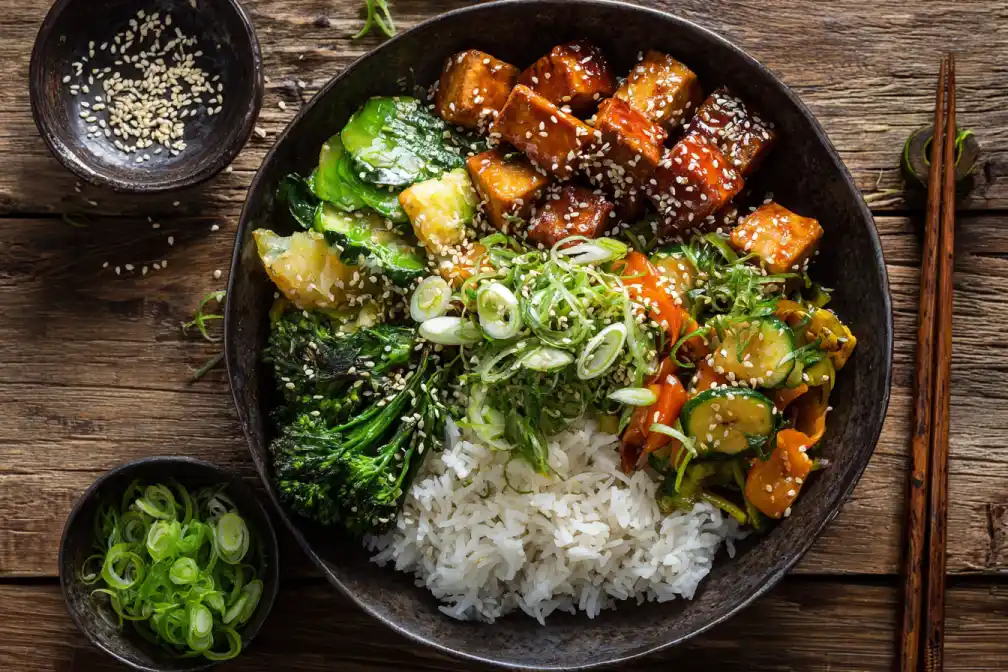Cooking a gochujang tofu rice bowl always takes me back to the first time I tasted the deep heat of Korean flavors while traveling through Seoul. I still remember standing in a small street-side eatery, where the sweet-spicy aroma of gochujang filled the air. The chef handed me a simple bowl layered with fluffy rice, crispy tofu, sautéed veggies, and a glossy red sauce that was bold, tangy, and unforgettable. That dish sparked my love for gochujang and inspired me to bring it into my Texas ranch kitchen, where I now experiment with balancing comfort food and global flavors.
This recipe is more than just a quick meal it’s nourishing, satisfying, and perfect for weeknights. The spicy-sweet kick of gochujang clings to golden tofu cubes, while crisp vegetables add freshness, and a drizzle of sesame oil ties everything together. Whether you’re new to Korean cooking or already a fan of gochujang, this rice bowl is approachable, delicious, and endlessly customizable.
Table of Contents
Table of Contents
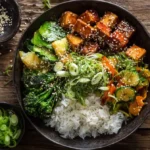
Gochujang Tofu Rice Bowl : A Flavorful Comfort Meal
- Total Time: 40 minutes
- Yield: 2 bowls
- Diet: Vegan
Description
A flavorful Korean-inspired gochujang tofu rice bowl with crispy tofu, steamed rice, sautéed vegetables, and spicy-sweet sauce.
Ingredients
1 block firm tofu, pressed and cubed
2 tablespoons cornstarch
2 tablespoons sesame oil, divided
2 tablespoons gochujang paste
2 tablespoons soy sauce
1 tablespoon rice vinegar
1 tablespoon honey or maple syrup
2 garlic cloves, minced
2 cups cooked jasmine or short-grain rice
1 cup carrots, julienned
1 cup zucchini, sliced
1 cup baby spinach
2 scallions, thinly sliced
1 tablespoon sesame seeds
1 fried egg (optional, for serving)
Instructions
Press tofu for 20 minutes and cut into cubes
Toss tofu with cornstarch, salt, and soy sauce
Pan-fry tofu in sesame oil until golden and crisp
Whisk together gochujang, soy sauce, rice vinegar, honey, garlic, and sesame oil for sauce
Toss tofu in sauce until evenly coated
Quickly sauté carrots and zucchini until crisp-tender; steam spinach separately
Assemble bowls by layering rice, vegetables, and tofu
Top with sesame seeds, scallions, and optional fried egg before serving
Notes
For a vegan version, use maple syrup instead of honey and skip the egg.
Air fryer or oven-bake the tofu for a lighter variation.
Add kimchi, avocado, or sriracha mayo for extra flavor twists.
- Prep Time: 20 minutes
- Cook Time: 20 minutes
- Category: Main Dish
- Method: Pan-fry and sauté
- Cuisine: Korean-inspired
The Heart of a Gochujang Tofu Rice Bowl
Essential Ingredients for Flavor
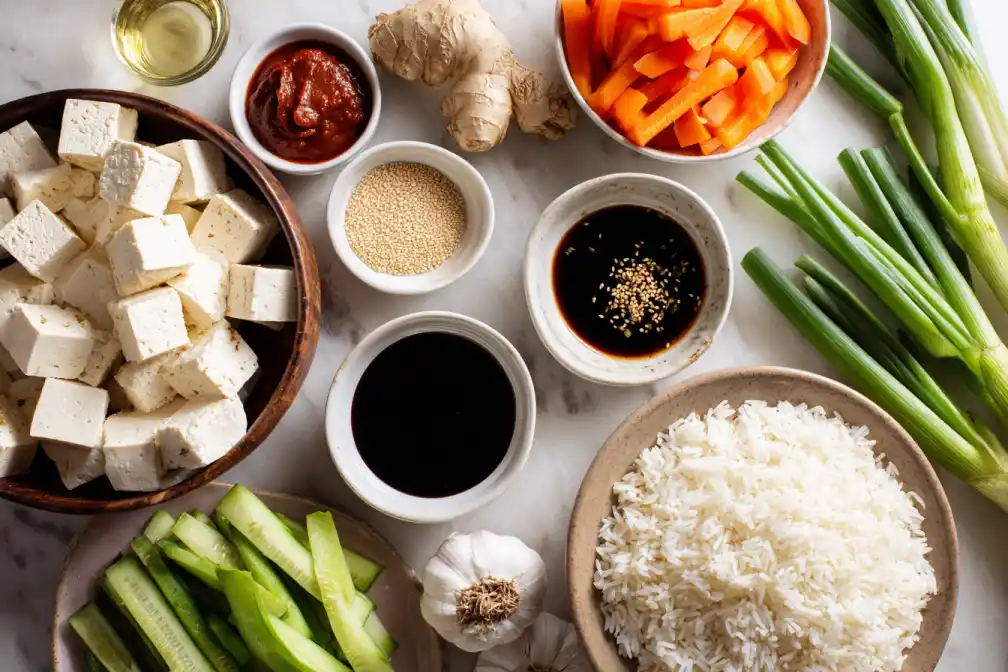
To make a great gochujang tofu rice bowl, the star ingredients matter. Firm tofu is best because it holds its shape when pan-fried to crispy perfection. Gochujang paste is the flavor driver rich, spicy, and slightly sweet. Supporting ingredients include garlic, soy sauce, sesame oil, and rice vinegar, which balance the heat. A mix of vegetables like carrots, zucchini, spinach, or bell peppers brings crunch and color, while steamed jasmine or short-grain rice serves as the comforting base. Garnishes such as sesame seeds, scallions, or a fried egg can elevate the bowl even further.
Building Layers of Taste
The secret is in layering flavors and textures. Start with a bed of warm rice, top it with crisp tofu tossed in gochujang sauce, then add sautéed or roasted vegetables for variety. A spoonful of kimchi adds a probiotic punch, while sesame oil provides a nutty aroma. The result is a bowl that’s balanced, bold, and comforting perfect for both busy weeknights and cozy weekends.
How to Make a Gochujang Tofu Rice Bowl
Preparing the Tofu
The first step to a satisfying gochujang tofu rice bowl is getting the tofu texture just right. Use firm or extra-firm tofu, and press it for at least 20 minutes to remove excess water. This step is crucial it allows the tofu to crisp up beautifully in the pan instead of turning soggy. Once pressed, cut it into bite-sized cubes, toss them lightly with cornstarch, salt, and a splash of soy sauce, then pan-fry until golden brown on all sides. For extra crispness, you can air fry or bake the tofu instead.
Cooking the Sauce and Assembling the Bowl
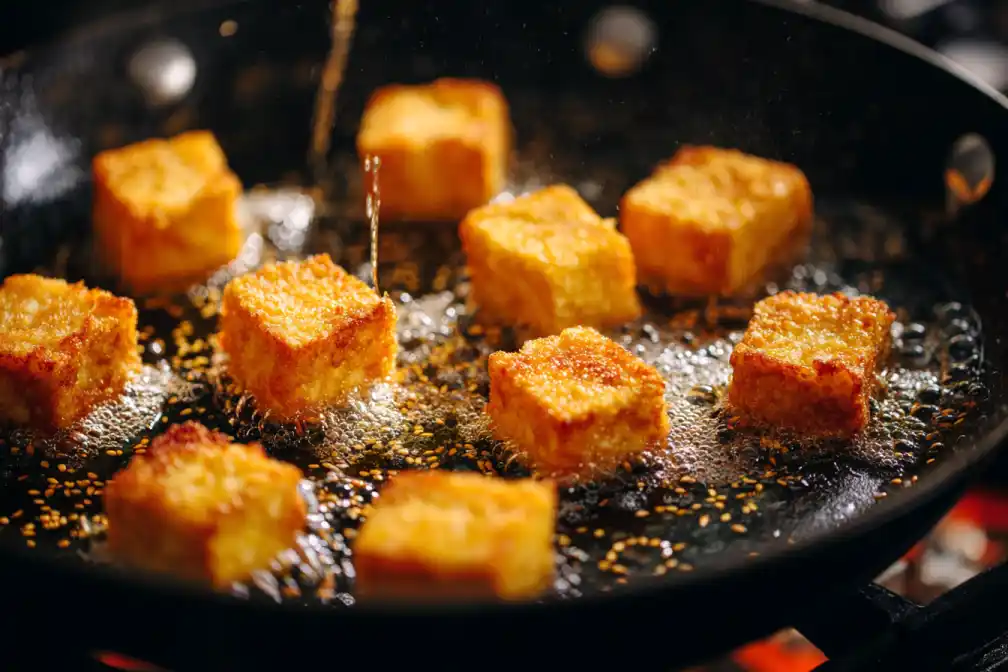
While the tofu cooks, prepare the sauce by whisking together gochujang, soy sauce, rice vinegar, honey (or maple syrup for a vegan option), garlic, and a touch of sesame oil. Once the tofu is golden, toss it in the sauce until coated with that irresistible spicy-sweet glaze.
For the vegetables, keep things simple but colorful. Sauté carrots, zucchini, or bell peppers quickly over high heat to retain crunch, or steam spinach for a softer bite. Layer everything over a warm bowl of steamed rice, then top with tofu and any extra sauce. Finish with sliced scallions, sesame seeds, and maybe even a fried or poached egg if you want extra richness.
Here’s a quick step-by-step breakdown:
| Step | What to Do |
|---|---|
| 1 | Press and cube tofu |
| 2 | Pan-fry tofu until golden |
| 3 | Whisk gochujang sauce ingredients |
| 4 | Toss tofu in sauce |
| 5 | Sauté or steam vegetables |
| 6 | Assemble rice bowl and garnish |
This simple flow makes the cooking process stress-free, so you can enjoy a hearty, flavorful bowl without spending hours in the kitchen.
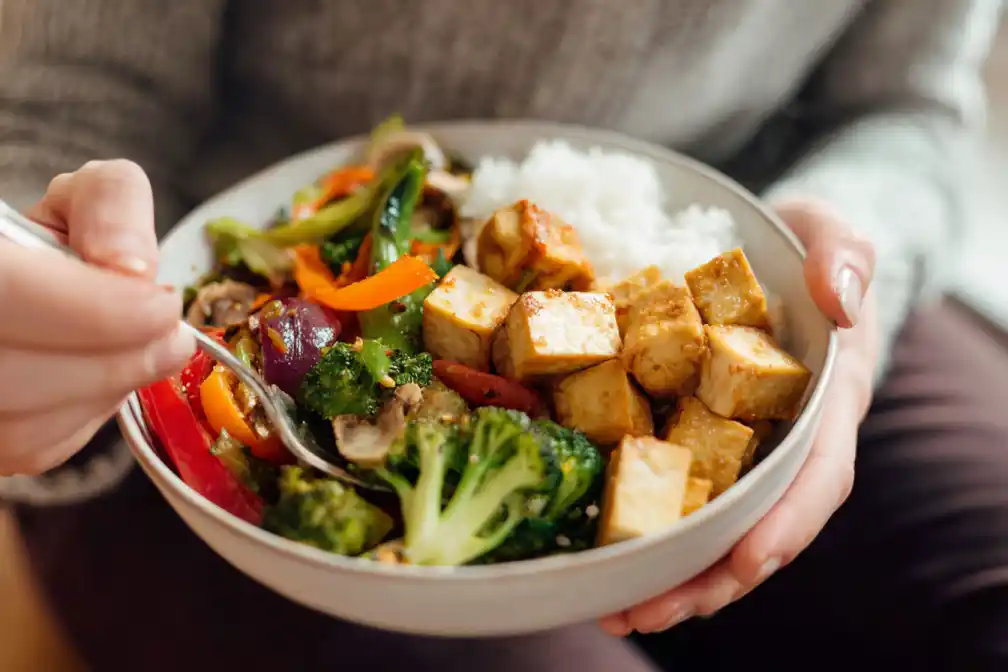
Serving and Garnishing a Gochujang Tofu Rice Bowl
Garnishes That Elevate the Bowl
The beauty of a gochujang tofu rice bowl is that it looks just as good as it tastes. Garnishes aren’t just decoration they add flavor, texture, and balance. A sprinkle of toasted sesame seeds brings nuttiness, while chopped scallions add brightness. If you enjoy bold flavors, a spoonful of kimchi on the side provides tang and probiotics. For creaminess, drizzle with a touch of sriracha mayo or top with a perfectly fried egg. Fresh cilantro or microgreens can also give the dish a refreshing finish. With these little additions, your bowl feels like something served at a trendy Korean bistro.
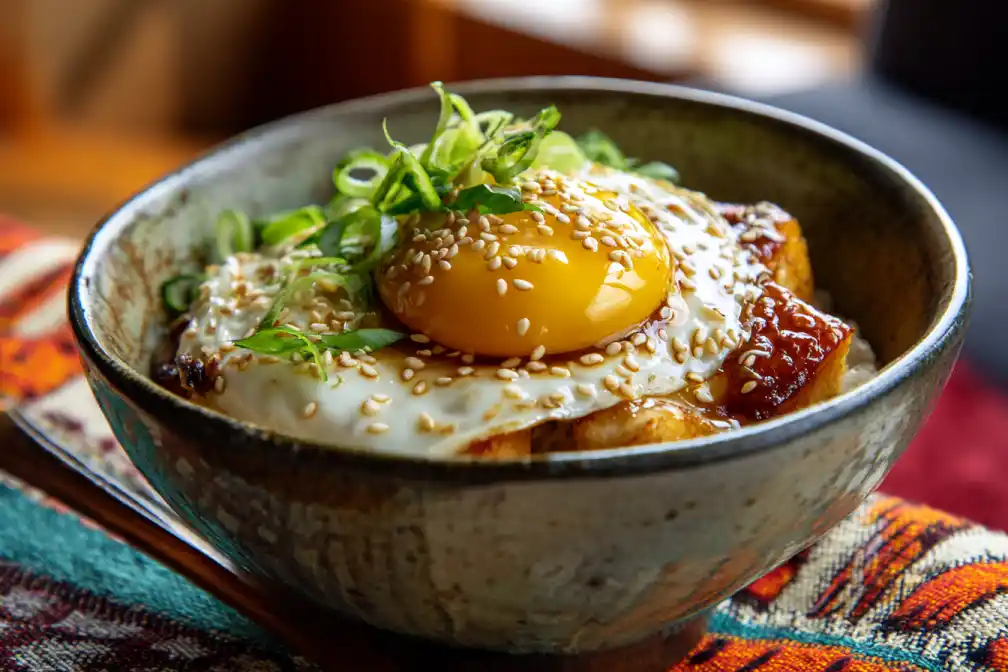
Common Mistakes to Avoid
Even a simple recipe like this has pitfalls. The most common mistake is skipping the tofu-pressing step, which leaves it too soft to crisp. Another error is overcooking the vegetables remember, you want them crisp-tender, not mushy. Be careful not to overload the sauce with too much gochujang, as it can become overpowering; balance is key. Finally, don’t forget the garnishes they’re what transform a good rice bowl into an outstanding one.
Here’s a quick checklist to avoid mistakes:
| Mistake | How to Fix It |
|---|---|
| Not pressing tofu | Press at least 20 minutes before cooking |
| Overcooking veggies | Stir-fry quickly over high heat |
| Sauce too strong | Add more soy sauce, honey, or rice vinegar |
| Skipping garnishes | Always finish with sesame, scallions, or kimchi |
When served correctly, the gochujang tofu rice bowl is colorful, nourishing, and deeply satisfying. It’s a dish that’s meant to be enjoyed slowly, letting the flavors unfold bite by bite. Whether you’re cooking for yourself or serving friends, this rice bowl always makes an impression at the table.
Storage, Reheating, and Creative Variations
How to Store and Reheat Leftovers
A gochujang tofu rice bowl is not only delicious fresh but also great for meal prep. Store leftover tofu, rice, and vegetables in separate airtight containers to keep textures intact. The tofu and rice will last up to four days in the refrigerator. When reheating, use a skillet instead of the microwave if possible this helps the tofu regain some crispness. If you do use a microwave, reheat in short bursts and drizzle with a little extra sesame oil or sauce to revive the flavors. For rice, sprinkle a few drops of water on top before reheating to prevent it from drying out.
Fun Variations to Try
One of the best parts about making a gochujang tofu rice bowl is how adaptable it is. If you want extra protein, swap in tempeh, chickpeas, or even seared shrimp. For a grain variation, try brown rice, quinoa, or cauliflower rice for a lighter base. Vegetables can also be rotated seasonally think roasted sweet potatoes in fall, fresh cucumbers in summer, or bok choy in winter. You can even make it fusion-style by adding avocado slices or a drizzle of peanut sauce.
Here’s a quick guide to variations:
| Swap | Idea |
|---|---|
| Protein | Tempeh, chickpeas, shrimp |
| Base | Brown rice, quinoa, cauliflower rice |
| Vegetables | Sweet potatoes, cucumbers, bok choy |
| Fusion Twist | Avocado, peanut sauce, sriracha mayo |
By mixing and matching, you’ll never get bored of this bowl. Each variation keeps the comforting base intact while offering something new. It’s the perfect recipe for busy lifestyles because you can adjust it to what’s already in your fridge, making it both practical and exciting.
Conclusion
The gochujang tofu rice bowl is more than just a recipe it’s a comforting, colorful, and deeply satisfying dish that balances bold Korean flavors with everyday simplicity. From the crispy tofu coated in spicy-sweet sauce to the fresh crunch of vegetables and the nutty aroma of sesame oil, every bite delivers warmth and excitement. It’s versatile enough for weeknight dinners, meal prep, or even entertaining guests with a vibrant, customizable spread. Whether you stick to the classic version or try one of the fun variations, this bowl will keep you coming back for more. Cooking it isn’t just about making food it’s about creating moments of comfort and joy in every bowl.
Explore More Delicious Recipes
👉 “Discover more easy recipes on Facebook and Instagram”
FAQs about Gochujang Tofu Rice Bowl
Can I make this gochujang tofu rice bowl vegan?
Yes! Simply use maple syrup or agave instead of honey, and skip the egg garnish. All the other ingredients are naturally plant-based.
What type of rice works best for this recipe?
Short-grain white rice or jasmine rice is ideal for a soft, slightly sticky base. However, you can use brown rice, quinoa, or even cauliflower rice for lighter options.
How spicy is the gochujang sauce?
The spice level depends on the brand and how much gochujang you use. If you’re sensitive to heat, start with 1 tablespoon and adjust to taste by balancing with honey or soy sauce.
Can I meal prep this dish ahead of time?
Absolutely. Prepare the rice and vegetables in advance, then store them separately from the tofu. When ready to eat, quickly reheat the tofu and rice, then assemble with fresh garnishes for the best texture.

